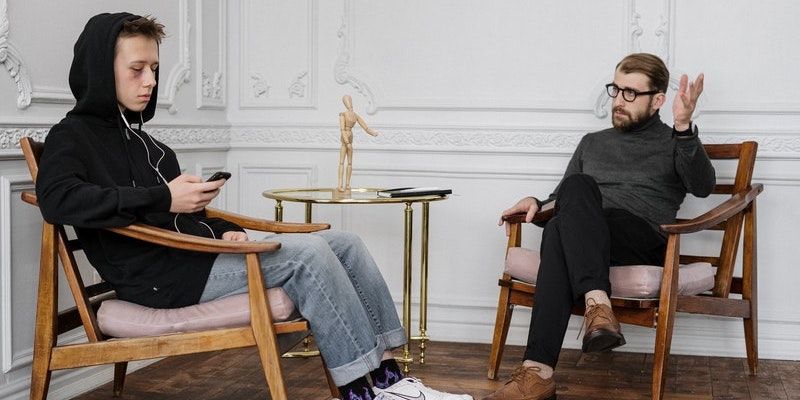Active Listening: The Art of Empathetic Conversation
 Active listening is at the heart of client-centered counseling and, once mastered, offers a powerful tool, valuable in our professional work, relationships, and personal lives (Miller & Rollnick, 2013).
Active listening is at the heart of client-centered counseling and, once mastered, offers a powerful tool, valuable in our professional work, relationships, and personal lives (Miller & Rollnick, 2013).
When done well, active listening builds and maintains therapeutic alliances and bonds by showing empathy and creating opportunities for healing and growth. By reflecting back the emotions we hear, the client experiences messages of support and encouragement to continue their therapeutic journey.
In counseling, therapy, and coaching, active listening is one of the most potent tools for improving in-session dynamics, overturning unhelpful mindsets, and supporting transformation.
Before you continue, we thought you might like to download our three Positive Communication Exercises (PDF) for free. These science-based tools will help you and those you work with build better social skills and better connect with others.
This Article Contains:
What Is Active Listening?
Richard Nelson-Jones (2014) says we should recognize the difference between hearing and listening. While hearing involves receiving sounds and interpreting their meaning, listening involves accurately understanding their meaning.
Listening goes beyond hearing and committing words to memory by becoming aware and sensitive to nonverbal communication, such as the speaker’s tone of voice, timing, speed of talking, body language, and context.
Active listening can be summed up as entailing “not only accurately understanding speaker’s communication but also showing that understanding” and therefore embodies the skills of both the sender and the receiver (Nelson-Jones, 2014, p. 79).
It can also be helpful to consider what active listening isn’t (Miller & Rollnick, 2013):
- Commanding
- Warning
- Lecturing
- Judging
- Blaming
- Shaming
- Analyzing
- Probing
- Humoring
- Distracting
Rather than examples of listening, each is a roadblock that gets in the way of the client’s self-exploration. The counselor, therapist, colleague, friend, and even loved one is saying, “Hold up, listen to me. I know best” (Miller & Rollnick, 2013).
The relationship with the client should take place within an egalitarian, nonhierarchical relationship, “with neither party occupying a ‘one-up’ or ‘one-down’ position in terms of status or authority” (Adams, 2016, p. 13).
Ultimately, the collaborative alliance must be fostered and maintained to allow goals, aspirations, fears, and plans to be worked through together.
What Is Empathetic Listening?

Accurate empathy is a helpful tool for facilitating self-exploration and, when used for communication within therapy or the workplace, can be game changing (Miller & Rollnick, 2013; Engel, 2018).
Simply put, empathic listening involves reflecting back the emotions we hear; for example, “You sound angry and upset.” It shows understanding, encouraging the speaker to share more by validating them without judgment.
Ultimately, it requires us to suspend our biases and ego, showing that we are listening to understand rather than reply (Engel, 2018). For someone telling important truths about how they feel or sharing the experiences they are going through, nothing hurts more than not being heard.
Communicating empathically requires vulnerability for both the speaker and listener. Honest, open communication means the speaker leaves themself open to challenge or ridicule. It is not all one sided; the listener may also feel some of their hurt and pain.
Why Is Active Listening as a Skill Important?
“Behind the discipline of good listening is a trust that it is useful for clients to explore their own experience and perceptions” (Miller & Rollnick, 2013, p. 49). Ultimately, it keeps people going, motivating them to enter uncomfortable areas of conversation and work through difficult material.
Listening occurs in four different contexts within counseling sessions (Nelson-Jones, 2014):
- Counselor listens to the therapist.
- Client listens to the counselor.
- Counselor listens to themself.
- Client listens to themself.
If someone is listening poorly or focusing too much on themself, they will miss out on much of what is being communicated. On the other hand, listening well, actively, to the other person can equally enhance their inner listening (Nelson-Jones, 2014).
Perhaps unsurprisingly, active listening is recognized as the central skill in forming and maintaining relationships within therapy and counseling.
How to Use Active Listening in Communication

It is possible to increase our understanding of what it takes to listen well, share and receive information, and form more robust emotional bonds (Abrahams & Groysberg, 2021; Westland, 2015).
Active listening in counseling
The American Psychological Association (n.d.) describes active listening as a “psychotherapeutic technique in which the therapist listens to a client closely, asking questions as needed, in order to fully understand the content of the message and the depth of the client’s emotion.”
Typically, it involves the counselor learning to practice the following.
Adopt an attitude of respect and acceptance
“An accepting attitude involves respecting clients as separate human beings with rights to their own thoughts and feelings” (Nelson-Jones, 2014, p. 82). As counselors, we must suspend any judgment of clients’ goodness or badness and recognize (as with our own) their capacity to fail based on the life skills they possess or are lacking.
We must also allow others to develop and grow at their own pace without trying to control or judge them. We must remain present and available, willing to let the clients’ experiences and emotions affect us.
Develop an understanding of our clients’ internal frame of reference
Active listening requires that we adopt the client’s perspective, understanding their internal frame of reference. Therefore, we must recognize and understand the separateness of “me” and “you” by breaking out of our internal frame of reference and learning to walk in their shoes.
Provide small rewards and use open-ended questions
“Small rewards are brief verbal and non-verbal expressions of interest designed to encourage clients to continue speaking” (Nelson-Jones, 2014, p. 96). When used well, they can motivate, support, and encourage the client, saying, “I’m here with you. Please continue.” They tell the client we are actively listening and would like to dig deeper.
Open-ended questions are powerful and a valuable way to promote active listening. “Do you feel your relationship is failing?” can be replaced with “How do you feel about your relationship?”
Closed questions can seem negative and potentially controlling, blocking clients’ access to their internal frame of reference.
Reflecting feelings
Reflecting feelings shows we are in tune with the other person. While similar to paraphrasing, it isn’t the same; we are “responding to clients’ music and not just their words” (Nelson-Jones, 2014, p. 102). It is difficult, requiring the listener to emphasize and experience the client’s emotional flow and then communicate it back.
One important skill that trainee counselors can learn involves listening for feeling words and phrases, including (Nelson-Jones, 2014):
- Angry
- Anxious
- Bored
- Cheerful
- Friendly
- Loved
- Tense
- Trusting
- Uneasy
Clients typically use a variety of feeling words, but they often cluster around central themes, such as a lack of self-confidence, difficulty coming to terms with loss, or fear of failing.
Once the counselor hears and understands these feelings, they can reflect them back, often using a variation of “You feel X because Y.”
“You’re angry and hurt because that person lied to you, and you can’t tell them anymore.”
Manage initial resistances
Resistance may present itself at any point during counseling. Perhaps the client is ambivalent, reluctant, or challenges the process based on what they think they need (Nelson-Jones, 2014).
Active listening skills can help with all forms of resistance. For example, a counselor encountering aggression, rather than challenging it or becoming sucked in, can reflect it back, showing, loud and clear, that the client’s feelings have been heard and registered.
Take the following example:
Client: “This is a waste of time. My parents are idiots; they just don’t get me.”
Counselor: “You are angry coming here because you feel your parents are the ones with the problems.”
Feedback can open up further discussion regarding the client’s feelings toward their parents and inform a greater understanding that can build the counseling relationship.
Active empathic listening
Active empathic listening involves going beyond the person’s words and fully grasping their emotions. While valuable in any situation, it is particularly beneficial during therapy and in times of crisis (Crisis Prevention Institute, 2016; Westland, 2015).
Sometimes simply being with a person in a state of high emotional upset can be enough, especially when we are unsure of what to say or how best to provide comfort. Showing compassion and being willing to share our time can offer great support, mainly when we are doing the following (Crisis Prevention Institute, 2016):
- Being nonjudgmental
- Giving the other person our undivided attention
- Listening carefully to feelings and facts
- Sitting comfortably with silence
- Using nonverbal messages to show we are listening and understanding
When clients are either overwhelmed by their emotions or unable to put feelings into words, being present, open, and authentic can offer an environment where they can find a safe place to calm down to share how they feel (Westland, 2015).
The art of active listening – Harvard Business Review
4 Active Listening Skills
Nelson-Jones (2014) suggests the following fundamental skills for effective active listening within the context of therapy sessions and beyond.
Receive voice messages accurately
How we frame our voice and our body can make significant differences to what we communicate, and it is vital that we maintain an awareness of each when speaking and listening. VAPER is a helpful acronym for monitoring and reviewing how our clients (or indeed ourselves) heighten or contradict the words we are using (modified from Nelson-Jones, 2014).
- Volume – How loudly or softly are we speaking?
- Articulation – Is our speech distinct? Does it lack clarity?
- Pitch – Are we pitching our voice too high or too low?
- Emphasis – Is our emphasis adequately contributing to the feelings we are sharing?
- Rate – Are we speaking too quickly, without adequate pauses, or so slowly that we appear weak or unmotivated?
Receive body messages accurately
Trainees and experienced counselors should pay particular attention to nonverbal messages shared by the client’s body. Such communication can indicate when they are holding back or concealing something, intentionally or otherwise.
Particular attention should be given to the following (Nelson-Jones, 2014):
- Facial expression – How does the expression on their face represent how they feel?
- Gaze – How much attention is directed at us? Where else are they looking?
- Eye contact – Are they avoiding deeper communication or giving too much away by restricting eye contact?
- Gestures – Are their gestures broad and sweeping or small, controlled, and inhibited?
- Posture – Does how they sit provide information regarding their degree of confidence?
- Physical closeness – Are they nearer or further away than four feet (a typical, acceptable distance between counselor and client)? And are there times they (or we) lean in closer to show interest or empathy?
Use paraphrasing
Mechanically parroting what another person is saying is annoying and damaging to the therapeutic relationship.
Instead, well-developed paraphrasing skills form part of active listening and show that the listener is engaged and understands what is being said (Nelson-Jones, 2014).
It is so effective that sparingly using the client’s words and staying close to their language style actually reward the speaker’s utterances.
Show awareness and understanding of context and differences
Clients’ problems have a context; they do not exist in a vacuum. For each person, the contextual variables vary, as does their relevance. We must consider what the following contextual factors mean for the client (Nelson-Jones, 2014):
- Culture
- Race
- Society
- Family
- Work/study
- Health/medical
- Gender
- Sexual orientation
- Age
- Religion
- Support network
For counselors, it becomes increasingly important to become familiar with values, assumptions, and shared experiences relevant to communities within each of these groups.
Active Listening Exercises & Techniques

For couples
Successful relationships rely on good communication, and communication in relationships can be improved with practice (Greiger, 2015).
- Validation
Couples must learn to validate one another. Rather than simply recognizing what their partners say, they can learn to validate how they feel. - Positive language
Learning to use positive language (rather than negative and critical language) can stop one partner from feeling ambushed or criticized. - Increased eye contact
Looking at our partners directly in a calm and relaxed way can increase understanding and reduce miscommunication. Have couples practice looking each other directly in the eyes for up to five minutes.
For kids
Children can also benefit from active listening, and it is a skill that will help them in multiple areas of their lives (Listenwise, n.d.).
- Stories and prediction
Sharing stories with children in groups and then asking them reflective questions encourages them to develop their active listening skills. - Creating questions
Children can practice their active listening skills by writing down questions while listening to their teacher talking. - Simon says
This fun game is a great way to ensure that children are competent listeners while learning how to focus and maintain their attention.
For parents
Parents should focus on active listening when communicating with their children. The following active listening techniques can help (The Center for Parenting Education, n.d.).
- Show that you are listening to your child; they must realize they are worthy of your attention.
- Hearing their upsets and their distress can help demonstrate the importance of their thoughts and feelings.
- Allowing a child time to choose their course of action shows that you trust their reasoning.
- Practice not judging your child and accepting (even if not agreeing) with what they say.
- Learn to be objective and keep your personal feelings separate from your child.
- Do not enter a conversation with a specific result in mind.
For managers
Active listening can form a valuable part of staff coaching, but it takes practice. Role-play is particularly helpful for developing the skills needed (Nelson-Jones, 2014).
Dealing with resistance
Work with a peer to practice overcoming resistance by using active listening skills. Practice situations where the employee is resistant to opening up about issues or difficulties at work by:
- Showing increased emotional understanding
- Giving them permission to be reluctant
- Engaging with the individual’s self-interest and self-protection
- Rewarding them for their talking and sharing
Preparing the environment
Ensure that the environment is safe and secure for an open discussion. It can be helpful to set boundaries if there are several people to ensure that people aren’t talked over and have the opportunity to ask questions.
Avoiding limiting language
Using the wrong sort of language can stop people from actively communicating. Try to avoid statements such as the following (Horton, 2019):
- Providing advice – “Why don’t you do this?” “You should try to …”
- Telling stories – “That reminds me of when I …”
- One-upping – “That’s nothing. You should have seen what happened when I …”
It is all too easy to stop people from openly communicating by suggesting that their views – what they think and how they feel – are less important.
Try these communication exercises for work to help implement active listening in the workplace.
Communication Resources From PositivePsychology.com
We have many resources available for improving the communication skills of therapists, counselors, and their clients.
Free resources include:
- Anger Exit and Re-Entry
Share this three-step process with clients to take a couple from conflict to constructive communication. - Conflict Resolution Checklist
A valuable 10-item checklist to help resolve conflict - Using “I” Statements
Using “I” Statements can be a straightforward way to communicate how you feel while simultaneously owning your feelings and outlining the details of the problem as you perceive it. - Assertive Communication
Understand the difference between assertive, aggressive, and passive communication by reflecting on personal scenarios.
More extensive versions of the following tools are available with a subscription to the Positive Psychology Toolkit©, but they are described briefly below:
- Active-Constructive Responding
This exercise introduces participants to the concept of capitalization interactions in which one person talks about something positive that happened to them, and another person responds to that disclosure. - Listening Without Trying to Solve
This tool is based on the concept of listening without problem-solving. The group exercise invites participants to pair up and experience two scenarios: (1) sharing a problem while being listened to and (2) sharing a problem while receiving advice and solutions.
If you’re looking for more science-based ways to help others communicate better, check out this collection of 17 validated positive communication tools for practitioners. Use them to help others improve their communication skills and form deeper and more positive relationships.
A Take-Home Message
Active listening is more than just sitting back quietly; it involves “what the interviewer says in response to what the speaker offers” (Miller & Rollnick, 2013, p. 49).
Rather than putting up roadblocks to open dialogue (blaming, shaming, and over-analyzing), the friend, colleague, family member, and therapist must show they are listening, understanding, and empathizing.
Neither party should aim for one-upmanship or authority, but rather should aim to form a collaborative alliance. When we show empathy as part of active listening, we encourage the speaker to share more by validating without judgment.
Active and empathetic listening is a vital skill in counseling. Mental health professionals adopt an attitude of respect and acceptance, understanding their client’s internal frame of reference and reflecting back feelings to show they are in tune.
To ensure active listening with clients, we must remain present and available. And perhaps most importantly, we must learn and have the courage to walk in their shoes.
We hope you enjoyed reading this article. Don’t forget to download our three Positive Communication Exercises (PDF) for free.
- Abrahams, R., & Groysberg, B. (2021, December 21). How to become a better listener. Harvard Business Review. Retrieved June 19, 2022, from https://hbr.org/2021/12/how-to-become-a-better-listener
- Adams, M. (2016). Coaching psychology in schools: Enhancing performance, development and wellbeing. Routledge.
- American Psychological Association. (n.d.) Active listening. In APA dictionary of psychology. Retrieved June 19, 2022, from https://dictionary.apa.org/active-listening
- The Center for Parenting Education. (n.d.). The skill of listening. Retrieved June 19, 2022, from https://centerforparentingeducation.org/library-of-articles/healthy-communication/the-skill-of-listening/
- Crisis Prevention Institute. (2016, October 12). 7 tips for empathic listening. Retrieved June 19, 2022, from https://www.crisisprevention.com/Blog/7-Tips-for-Empathic-Listening
- Listenwise. (n.d.). Developing listening skills for kids. Retrieved June 19, 2022, from https://listenwise.com/active_listening_kids
- Engel, J. (2018, December 19). How empathic and active listening can improve workplace communication. Forbes. Retrieved June 19, 2022, from https://www.forbes.com/sites/forbescoachescouncil/2018/12/19/how-empathic-and-active-listening-can-improve-workplace-communication/
- Greiger, R. (2015). The couples therapy companion: A cognitive behavior workbook. Routledge.
- Horton, A. (2019, July 7). How I learned to be better at active listening as a manager. Fast Company. Retrieved June 19, 2022, from https://www.fastcompany.com/90372821/how-i-learned-to-be-better-at-active-listening-as-a-manager
- Miller, W. R., & Rollnick, S. (2013). Motivational interviewing: Preparing people for change. Guilford Press.
- Nelson-Jones, R. (2014). Practical counselling and helping skills. Sage.
- Westland, G. (2015). Verbal and non-verbal communication in psychotherapy. W.W. Norton & Company.
Let us know your thoughts
Read other articles by their category
- Body & Brain (49)
- Coaching & Application (57)
- Compassion (26)
- Counseling (51)
- Emotional Intelligence (24)
- Gratitude (18)
- Grief & Bereavement (21)
- Happiness & SWB (40)
- Meaning & Values (26)
- Meditation (20)
- Mindfulness (45)
- Motivation & Goals (45)
- Optimism & Mindset (34)
- Positive CBT (28)
- Positive Communication (20)
- Positive Education (47)
- Positive Emotions (32)
- Positive Leadership (18)
- Positive Parenting (3)
- Positive Psychology (33)
- Positive Workplace (37)
- Productivity (16)
- Relationships (46)
- Resilience & Coping (36)
- Self Awareness (21)
- Self Esteem (37)
- Strengths & Virtues (31)
- Stress & Burnout Prevention (34)
- Theory & Books (46)
- Therapy Exercises (37)
- Types of Therapy (64)





What our readers think
Straight forward and easy to read, with good advice and takeaways.
its really helpful.
Its helpful to us for learning.